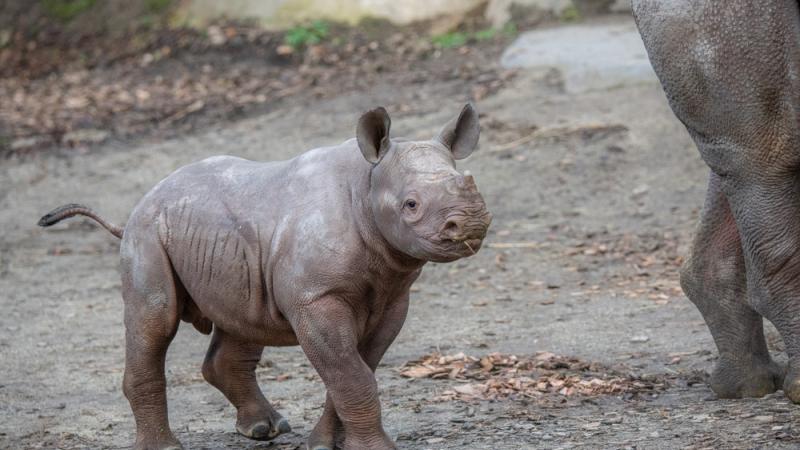It's a boy! Endangered rhino calf hits 2 month milestone

Eastern black rhinoceros baby is growing up fast, exploring Rhino Ridge
The tiniest rhinoceros at the Oregon Zoo turned 2 months old this week, and veterinary staff confirmed that he’s a boy. Born Dec. 4 at around 100 pounds, the youngster now weighs around 225 and is beginning to venture outside for short periods of time.
“We’re giving Jozi and her calf plenty of space to bond, so we weren’t sure if the calf was a boy or a girl until the vet team paid him a visit — though we had our guesses,” said Chad Harmon, who supervises the zoo’s rhino area. “This not-so-little guy is growing fast and Jozi continues to be a great mom.”
Jozi and her baby are mostly off-view to allow the new family a comfortable place to continue to bond, but the calf hit another big milestone over the weekend: The weather was warm and dry enough for him to venture outside for the first time.
“He poked his little head out and walked around for a few minutes,” Harmon said. “Then he went back into the barn with Mom and took a nap.”
Lucky guests might get a quick glimpse of Jozi and her baby on warm, dry days, but Harmon says they’ll be spending most of their time in the maternity den until spring. Care staff are still deciding on a name for the calf.
Harmon, a longtime rhino benefactor, is a board member of the International Rhino Keeper Association, which works to develop and share best practices for caregivers and contribute to rhino conservation.
Jozi’s baby holds much significance for the species, according to Kelly Gomez, who oversees the zoo’s Africa area. Jozi and her companion, King, belong to the eastern subspecies of black rhinoceros, which is considered critically endangered. In 2011, the western subspecies of black rhino was declared extinct.
“These rhinos represent a species that’s among the most imperiled on the planet,” Gomez said. “Hopefully, their story can help inspire a new chapter in their conservation.”
“We’ve gone from half a million to a few thousand rhinos left in the blink of an eye,” noted U.K. naturalist Steve Backshall. “While those left in the wild are ludicrously precious, the rhinos that are in zoos (which were bred there, born there and cannot ever be released into the wild) are of disproportionate importance to their kind.”
Jozi, who weighs around 2,400 pounds, was born Sept. 8, 2012, at the Pittsburgh Zoo. Keepers named her after her parents: “Jo-” from her father, Jomo, and “-zi” from her mother, Azizi.
Jozi moved to the Oregon Zoo in 2021 from to the Milwaukee County Zoo, joining male rhino King, the baby’s father, who arrived from Chicago’s Brookfield Zoo earlier that year. The moves were based on a recommendation from the Association of Zoos and Aquariums’ Species Survival Plan for rhinos. The AZA has established Species Survival Plans for many threatened or endangered species — cooperative programs that help create genetically diverse, self-sustaining populations to guarantee the long-term future of these animals.
More News

Rescued cougar cubs are venturing out
A pair of orphaned cougar cubs, rescued and brought to the zoo by Washington Department of Fish and Wildlife staff in November, have begun exploring their outdoor habitat.April 17, 2025

Zoo seeks pika watchers for summer season
The Oregon Zoo is recruiting volunteers for Cascades Pika Watch.April 15, 2025

Zoo convenes action for imperiled elephants
Sabah government representatives joined conservation NGOs, local communities, palm oil producers, and tourism operators this week in the fight to save the world’s smallest elephants from extinction.April 11, 2025

